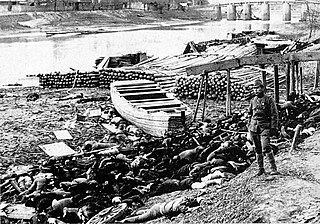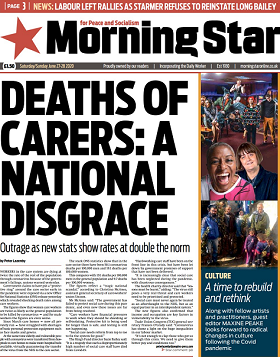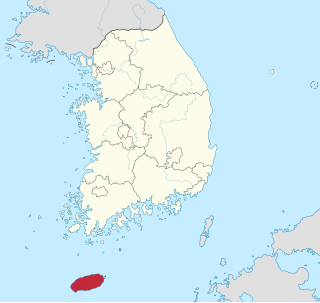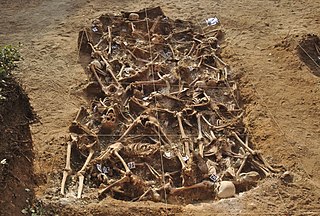
The Nanjing Massacre or the Rape of Nanjing was the mass murder of Chinese civilians in Nanjing, the capital of the Republic of China, immediately after the Battle of Nanking and the retreat of the National Revolutionary Army in the Second Sino-Japanese War, by the Imperial Japanese Army. Beginning on December 13, 1937, the massacre lasted six weeks. The perpetrators also committed other war crimes such as mass rape, looting, torture, and arson. The massacre is considered to be one of the worst wartime atrocities.

The Morning Star is a left-wing British daily newspaper with a focus on social, political and trade union issues. Originally founded in 1930 as the Daily Worker by the Communist Party of Great Britain (CPGB), ownership was transferred from the CPGB to an independent readers' co-operative, the People's Press Printing Society, in 1945 and later renamed the Morning Star in 1966. The paper describes its editorial stance as in line with Britain's Road to Socialism, the programme of the Communist Party of Britain.

Daejeon is South Korea's fifth-largest metropolis, with a population of 1.5 million as of 2019. Located in a central lowland valley alongside forested hills and the Geum River, the city is known for its technology and research institutions, and for celebrating its natural environment, with most mountains, hot springs, and rivers freely open for public use. Daejeon serves as a hub of transportation for major rail and road routes, and is approximately 50 minutes from the capital, Seoul, by KTX or SRT high speed rail.

The Jeju uprising, known in South Korea as the Jeju April 3 incident, was an uprising on Jeju Island from April 1948 to May 1949. A year prior to its start, residents of Jeju had begun protesting elections scheduled by the United Nations Temporary Commission on Korea (UNTCOK) to be held in the United States-occupied half of Korea, which they believed would entrench the division of the country. A general strike was later organised by the Workers' Party of South Korea (WPSK) from February to March 1948. The WPSK launched an insurgency in April 1948, attacking police and Northwest Youth League members stationed on Jeju who had been mobilized to suppress the protests by force. The First Republic of Korea under President Syngman Rhee escalated the suppression of the uprising from August 1948, declaring martial law in November and beginning an "eradication campaign" against rebel forces in the rural areas of Jeju in March 1949, defeating them within two months. Many rebel veterans and suspected sympathizers were later killed upon the outbreak of the Korean War in June 1950, and the existence of the Jeju uprising was officially censored and repressed in South Korea for several decades.

A mass grave is a grave containing multiple human corpses, which may or may not be identified prior to burial. The United Nations has defined a criminal mass grave as a burial site containing three or more victims of execution, although an exact definition is not unanimously agreed upon. Mass graves are usually created after many people die or are killed, and there is a desire to bury the corpses quickly for sanitation concerns. Although mass graves can be used during major conflicts such as war and crime, in modern times they may be used after a famine, epidemic, or natural disaster. In disasters, mass graves are used for infection and disease control. In such cases, there is often a breakdown of the social infrastructure that would enable proper identification and disposal of individual bodies.

The Khojaly massacre was the mass killing of Azerbaijani civilians by Armenian forces and the 366th CIS regiment in the town of Khojaly on 26 February 1992. The event became the largest single massacre throughout the entire Nagorno-Karabakh conflict.

In Chechnya, mass graves containing hundreds of corpses have been uncovered since the beginning of the Chechen wars in 1994. As of June 2008, there were 57 registered locations of mass graves in Chechnya. According to Amnesty International, thousands may be buried in unmarked graves including up to 5,000 civilians who disappeared since the beginning of the Second Chechen War in 1999. In 2008, the largest mass grave found to date was uncovered in Grozny, containing some 800 bodies from the First Chechen War in 1995. Russia's general policy to the Chechen mass graves is to not exhume them.

Mass graves in Iraq have become well known since the 2003 invasion of Iraq toppled the regime of Saddam Hussein. International Experts estimated that 300,000 victims could be in these mass graves alone. The mass graves mostly included the remains of Shia Muslims and ethnic Kurds, who were killed for opposing the regime between 1983 and 1991.

The Bodo League massacre was a massacre and a war crime against communists and alleged communist-sympathizers that occurred in the summer of 1950 during the Korean War. Estimates of the death toll vary. Historians and experts on the Korean War estimate that between 60,000 and 200,000 people were killed.

The Truth and Reconciliation Commission, established on December 1, 2005, is a South Korean governmental body responsible for investigating incidents in Korean history which occurred from Japan's rule of Korea in 1910 through the end of authoritarian rule in South Korea with the election of President Kim Young-sam in 1993.

Anti-communist mass killings are the politically motivated mass killings of communists, alleged communists, or their alleged supporters which were committed by anti-communists and political organizations or governments which opposed communism. The communist movement has faced opposition since it was founded and the opposition to it has often been organized and violent. Many anti-communist mass killing campaigns waged during the Cold War were supported and backed by the United States and its Western Bloc allies. Some U.S.-supported mass killings, including the Indonesian mass killings of 1965–66 and the killings by the Guatemalan military during the Guatemalan Civil War, are considered acts of genocide.
The massacres in Piaśnica were a series of mass murders carried out by Nazi Germany during World War II, between the fall of 1939 and spring of 1940 in Piaśnica Wielka in the Darzlubska Wilderness near Wejherowo. The exact number of people murdered is unknown, but estimates range between 12,000 and 14,000 victims. Most of them were Polish intellectuals from Gdańsk Pomerania, but Poles, Kashubians, Jews, Czechs and German inmates from mental hospitals from the General Government and the Third Reich were also murdered. After the Stutthof concentration camp, Piaśnica was the largest site of killings of Polish civilians in Pomerania by the Germans, and for this reason, is sometimes referred to as the "second" or "Pomeranian" Katyn. It was the first large-scale Nazi atrocity in occupied Poland.

The No Gun Ri massacre was a mass killing of South Korean refugees by U.S. military air and ground fire near the village of Nogeun-ri (노근리) in central South Korea between July 26 and 29, 1950, early in the Korean War. In 2005, a South Korean government inquest certified the names of 163 dead or missing and 55 wounded, and added that many other victims' names were not reported. The No Gun Ri Peace Foundation estimates 250–300 were killed, mostly women and children.
The Darayya massacre was a massacre carried out by Syrian government forces of Bashar al-Assad that occurred between 20 and 25 August 2012 in the town of Darayya in the Rif Dimashq province of Syria, during the Syrian civil war.
The December massacres were a series of politically motivated executions carried out by the South Korean government following the recapture of Pyongyang by communist forces in the Korean War. The killings took place in South Korea, but mainly in and around Seoul. It is believed the South Korean government executed thousands of people, however accurate estimates are difficult to come by. The Rhee regime received criticism from the international community and the executions damaged his image.
The Korean War was a major conflict of the Cold War and among the most destructive conflicts of the modern era, with approximately 3 million killed, most of whom were civilians. It resulted in the destruction of virtually all of Korea's major cities, with thousands of massacres committed by both sides—including the mass killing of tens of thousands of suspected communists by the South Korean government, and the torture and starvation of prisoners of war by the North Koreans. North Korea became among the most heavily bombed countries in history.

Alan Winnington was a British journalist, war correspondent, movie actor, anthropologist, and Communist activist, most notable for his coverage of the Korean War and the Chinese revolution. In 1950, Winnington authored I saw the truth in Korea, an anti-war pamphlet containing photographic evidence of the mass graves of civilians executed by the South Korean police. The publishing of this leaflet led to the British government debating whether to have Winnington tried for treason, a charge which carried the death penalty, though it was instead decided to make him stateless by refusing to renew his passport.
The Goda massacre was a mass extrajudicial killing that took place at the Goda Bottle and Glass Share Company in Gu'iguna in the Tigray Region of Ethiopia during the Tigray War, on 2 December 2020. Gu'iguna is a hamlet just north of Idaga Hamus town, Eastern zone of Tigray.

The Bucha massacre was the mass murder of Ukrainian civilians and prisoners of war by the Russian Armed Forces during the fight for and occupation of the city of Bucha as part of the Russian invasion of Ukraine. Photographic and video evidence of the massacre emerged on 1 April 2022 after Russian forces withdrew from the city.














